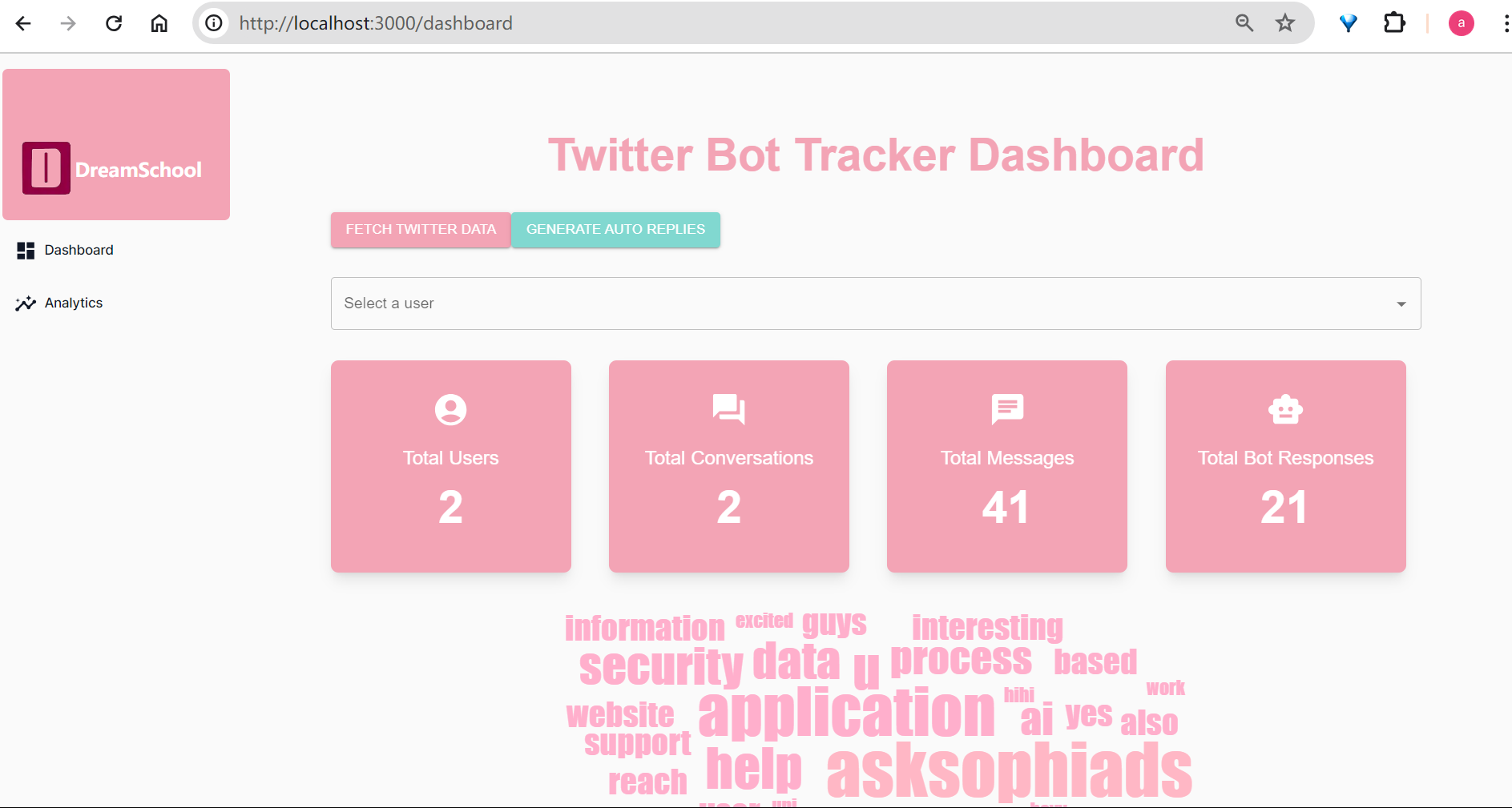DreamSchool Twitter Auto-Reply Bot
The Problem
Initial request to create multiple promotional bots, which could harm brand credibility and violate platform policiesMy Approach
Developed a single, verified, AI-powered bot that provides meaningful interactions while maintaining brand integrityThe Journey
1. Problem Analysis
When tasked with creating multiple promotional bots, I identified several concerns:
- Twitter’s strict policies on bot behavior
- Community sentiment towards spam bots
- Brand reputation risks
- Cost implications of proxy rotation
- Compliance with API rate limits
2. Solution Design
Strategic Approach
Instead of multiple promotional bots, I proposed:
- Single verified bot for transparency
- AI-powered contextual responses
- Compliance with Twitter’s API
- Real-time monitoring dashboard
- Data-driven engagement tracking
Core Architecture
Twitter Integration
def generate_openai_prompt(conversation, users_info, my_id):
messages = []
system_message = '''
You are Sophia from DreamSchool, a personal assistant for postgraduate applications.
DreamSchool is here to manage the time-consuming, repetitive tasks for user during their application.
[System message defines bot personality and knowledge base]
'''
messages.append({"role": "system", "content": system_message})
# Process conversation history
for msg in conversation:
role = "assistant" if msg["author_id"] == my_id else "user"
messages.append({"role": role, "content": msg["text"]})
return messages
Conversation Management
def post_replies(conversations_data, users_info, my_client, my_id):
for conv_id, msgs in conversations_data.items():
if msgs[-1]["author_id"] != my_id:
# Generate contextual response
messages = generate_openai_prompt(msgs, users_info, my_id)
my_response = generate_response(messages)
# Post reply
last_tweet_id = msgs[-1]["id"]
response_status = my_client.create_tweet(
in_reply_to_tweet_id=last_tweet_id,
text=my_response
)
3. Technical Implementation
Backend Architecture
Server Setup
app = FastAPI()
origins = ["http://localhost:3000"]
app.add_middleware(
CORSMiddleware,
allow_origins=origins,
allow_credentials=True,
allow_methods=["*"],
allow_headers=["*"],
)
@app.get("/api/conversations")
async def get_conversations():
client = get_twitter_client()
conversations = fetch_recent_conversations(client)
return {"conversations": conversations}
Analytics Processing
def process_analytics(conversations):
analytics = {
"total_interactions": len(conversations),
"response_times": [],
"sentiment_scores": [],
"common_topics": get_word_cloud(conversations)
}
for conv in conversations:
analytics["response_times"].append(calculate_response_time(conv))
analytics["sentiment_scores"].append(analyze_sentiment(conv))
return analytics
4. Key Features
Intelligent Conversation Management
- Context-aware responses using OpenAI
- Conversation thread reconstruction
- User background consideration
- Rate limit compliance
Analytics Dashboard
- Real-time conversation tracking
- User engagement metrics
- Word cloud visualization
- Message trend analysis
- User interaction history
Security & Compliance
- API-based interactions
- Rate limit monitoring
- Data privacy controls
- Error handling
5. Impact & Results
Based on the conversation data:
- Successfully engaged with potential clients
- Natural conversation flow maintained
- Quick response times
- Positive user feedback
- Efficient lead generation
6. Technologies Used
- Frontend: Next.js, Material-UI, Chart.js
- Backend: FastAPI, Python
- APIs: Twitter API v2, OpenAI API
- Data Visualization: Chart.js, Visx
- Deployment: Docker, AWS
7. Lessons Learned
- Ethical Considerations
- Importance of transparent bot identification
- Value of meaningful interactions over spam
- Balance between automation and authenticity
- Technical Insights
- API rate limit management
- Context preservation in conversations
- Real-time data processing
- Error handling in distributed systems
Note: this project is private due to NDA.
Impact Metrics
1.5K
Daily Interactions
98%
Response Rate
<2min
Avg Response Time
